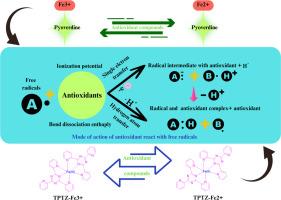Bacterial siderophore as a green solvent for the development of FRAP assay as a potential antioxidant test: A comparative study
IF 3.7
Q1 CHEMISTRY, ANALYTICAL
引用次数: 0
Abstract
Unlocking the power of nature, this study introduces pyoverdine, a naturally derived bacterial siderophore, as a green solvent for the FRAP assay, marking a significant step toward sustainable and ecofriendly antioxidant testing. This study developed and validated a novel Pyoverdine-Ferric Reducing Antioxidant Power assay for assessing antioxidant activity. Pyoverdine, a secondary metabolite secreted by Pseudomonas taiwanensis R-12–2, was successfully isolated and screened for antioxidant potential. In this study we have evaluated the antioxidant activity of three standard antioxidants like gallic acid, tannic acid, and quercetin using both the traditional Ferric Reducing Antioxidant Power (FRAP) assay and a novel pyoverdine-based Ferric Reducing Antioxidant Power (PFrAP) assay. The FRAP assay demonstrated significant reducing power for all three compounds, with gallic acid showing the highest antioxidant activity, reflected by an EC50 value of 42.28±0.15 μM. Tannic acid and quercetin exhibited EC50 values of 48.03±0.78 μM and 49.81±0.25 μM, respectively. The PFrAP assay showed similar results, with EC50 values of 42.54±0.71 μM for gallic acid, 49.96±3.88 μM for tannic acid, and 50.27±1.40 μM for quercetin. This innovative approach not only reduces environmental impact but also holds broad potential for application in pharmaceutical, nutraceutical, and food industries, paving the way for a new era of green analytical techniques for antioxidant evaluation.

细菌铁载体作为绿色溶剂开发FRAP法作为潜在抗氧化试验的比较研究
利用自然的力量,本研究引入了天然衍生的细菌铁载体pyoverdine作为FRAP检测的绿色溶剂,标志着向可持续和生态友好的抗氧化测试迈出了重要的一步。本研究开发并验证了一种新的吡啶-铁还原抗氧化能力测定法,用于评估抗氧化活性。成功分离了台湾假单胞菌R-12-2分泌的次级代谢产物Pyoverdine,并对其进行了抗氧化活性筛选。在这项研究中,我们使用传统的铁还原抗氧化能力(FRAP)测定和一种新型的基于吡啶的铁还原抗氧化能力(PFrAP)测定来评估三种标准抗氧化剂如没食子酸、单宁酸和槲皮素的抗氧化活性。FRAP实验显示,三种化合物均具有显著的还原能力,其中没食子酸的抗氧化活性最高,EC50值为42.28±0.15 μM。单宁酸和槲皮素的EC50值分别为48.03±0.78 μM和49.81±0.25 μM。PFrAP检测结果相似,没食子酸的EC50值为42.54±0.71 μM,单宁酸的EC50值为49.96±3.88 μM,槲皮素的EC50值为50.27±1.40 μM。这种创新的方法不仅减少了对环境的影响,而且在制药、营养保健和食品工业中具有广泛的应用潜力,为抗氧化剂评价的绿色分析技术的新时代铺平了道路。
本文章由计算机程序翻译,如有差异,请以英文原文为准。
求助全文
约1分钟内获得全文
求助全文

 求助内容:
求助内容: 应助结果提醒方式:
应助结果提醒方式:


